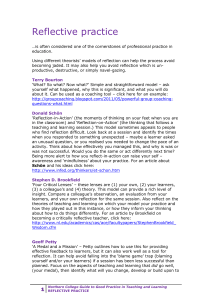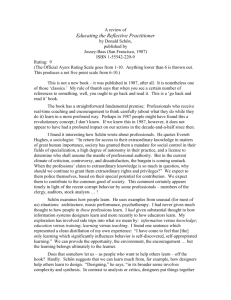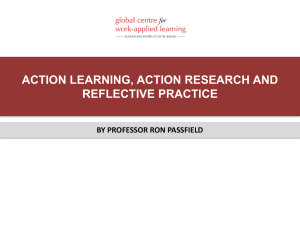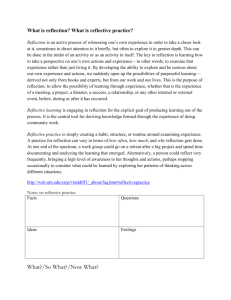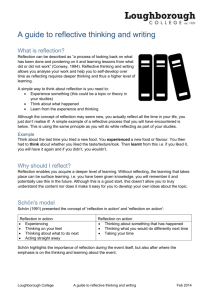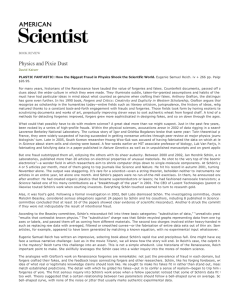THE USE OF PROFESSIONAL REFLECTION AND PROFESSIONAL
advertisement
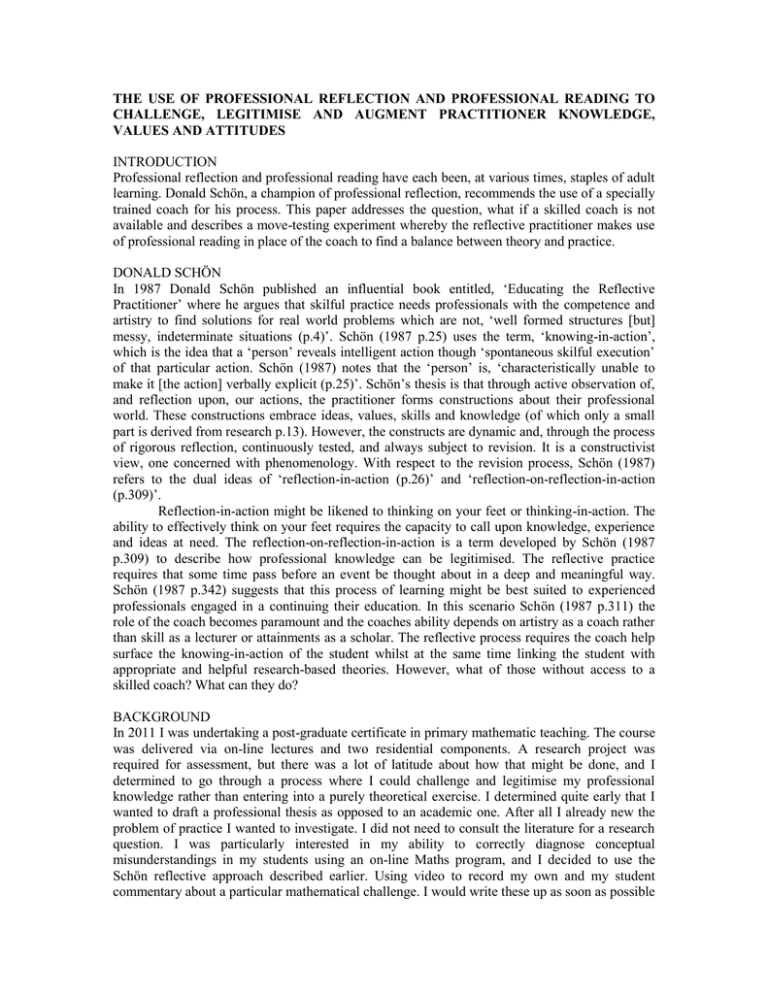
THE USE OF PROFESSIONAL REFLECTION AND PROFESSIONAL READING TO CHALLENGE, LEGITIMISE AND AUGMENT PRACTITIONER KNOWLEDGE, VALUES AND ATTITUDES INTRODUCTION Professional reflection and professional reading have each been, at various times, staples of adult learning. Donald Schön, a champion of professional reflection, recommends the use of a specially trained coach for his process. This paper addresses the question, what if a skilled coach is not available and describes a move-testing experiment whereby the reflective practitioner makes use of professional reading in place of the coach to find a balance between theory and practice. DONALD SCHÖN In 1987 Donald Schön published an influential book entitled, ‘Educating the Reflective Practitioner’ where he argues that skilful practice needs professionals with the competence and artistry to find solutions for real world problems which are not, ‘well formed structures [but] messy, indeterminate situations (p.4)’. Schön (1987 p.25) uses the term, ‘knowing-in-action’, which is the idea that a ‘person’ reveals intelligent action though ‘spontaneous skilful execution’ of that particular action. Schön (1987) notes that the ‘person’ is, ‘characteristically unable to make it [the action] verbally explicit (p.25)’. Schön’s thesis is that through active observation of, and reflection upon, our actions, the practitioner forms constructions about their professional world. These constructions embrace ideas, values, skills and knowledge (of which only a small part is derived from research p.13). However, the constructs are dynamic and, through the process of rigorous reflection, continuously tested, and always subject to revision. It is a constructivist view, one concerned with phenomenology. With respect to the revision process, Schön (1987) refers to the dual ideas of ‘reflection-in-action (p.26)’ and ‘reflection-on-reflection-in-action (p.309)’. Reflection-in-action might be likened to thinking on your feet or thinking-in-action. The ability to effectively think on your feet requires the capacity to call upon knowledge, experience and ideas at need. The reflection-on-reflection-in-action is a term developed by Schön (1987 p.309) to describe how professional knowledge can be legitimised. The reflective practice requires that some time pass before an event be thought about in a deep and meaningful way. Schön (1987 p.342) suggests that this process of learning might be best suited to experienced professionals engaged in a continuing their education. In this scenario Schön (1987 p.311) the role of the coach becomes paramount and the coaches ability depends on artistry as a coach rather than skill as a lecturer or attainments as a scholar. The reflective process requires the coach help surface the knowing-in-action of the student whilst at the same time linking the student with appropriate and helpful research-based theories. However, what of those without access to a skilled coach? What can they do? BACKGROUND In 2011 I was undertaking a post-graduate certificate in primary mathematic teaching. The course was delivered via on-line lectures and two residential components. A research project was required for assessment, but there was a lot of latitude about how that might be done, and I determined to go through a process where I could challenge and legitimise my professional knowledge rather than entering into a purely theoretical exercise. I determined quite early that I wanted to draft a professional thesis as opposed to an academic one. After all I already new the problem of practice I wanted to investigate. I did not need to consult the literature for a research question. I was particularly interested in my ability to correctly diagnose conceptual misunderstandings in my students using an on-line Maths program, and I decided to use the Schön reflective approach described earlier. Using video to record my own and my student commentary about a particular mathematical challenge. I would write these up as soon as possible after the lesson. These each became my initial reflection-in-action. As the students spoke to camera I also noted what was I thinking; specifically, what conceptual weakness did I think my student was demonstrating right then. I was thinking on my feet. The refection-on-reflection-inaction followed sometime later after a review of appropriate literature both in book form and from the education department’s own website. The reflection-on-reflection-in-action required an honest appraisal of the effectiveness of my original diagnoses. As an aside, my procedural fixes were usually good but my conceptual diagnoses were found a little wanting. No surprise really, that’s why I was on the course! Engaging in rigorous professional reading before the reflectionon-reflection-in-action proved to be a very effective way to test my own earlier thinking. By this I mean I challenged, legitimised and augmented my pedagogical knowledge around mathematics. At the same time as I was completing the above course I was coordinating an aspirant leadership program for my school’s sub-region and professional reflection was a major component of the program. However, it was taking a long time to write a dozen reflections after which I engaged the aspirants in constructing a repertory grid using these same reflections. Repertory grid technique is an instrument of personal construct theory and is a way to surface a person’s world-view. I needed a process where the aspirants could get into a deeply reflective process in a more timely manner. Another factor that came into play was the depth of theoretical content provided to the aspirants was being steadily reduced as the sub-regions were expected to become more self-sufficient. When I began coordinating the process a team from a university did this work with us at different times throughout the year. They were subsequently replaced with a group of consultants who hosted two days. However, by the time I had introduced the reflective process we were engaging a single consultant for one day. Leadership and management philosophy had taken a back seat to pragmatic professional development managing teams like running meetings, having difficult conversations and dealing with underperforming staff. We needed to find a balance between practice and theory. MOVE TESTING EXPERIMENT Schön (1987 p. 70) discusses the differences between academic and professional experimentation and makes the point that the rigor strived for in hypothesis testing is not possible under the conditions prevailing in professional practice. Schön (1987 p.73) claims that practitioners will set up an experiment with a desired outcome in mind and will manipulate the variables, if they can, to make their hypothesis come true. As well as hypothesis testing Schön (1987 p.70-71) also describes other forms of experimentation carried out by practitioners like exploratory experimentation and move-testing experimentation. Exploratory experimentation describes an approach where an, ‘action is undertaken only to see what follows, without the accompanying predictions or expectations’. Move-testing is, ‘an action undertaken with an end in mind … one either gets the intended consequence or does not’. Based on what happened in 2011 I decided to engage in a ‘Move-testing’ experiment around engaging the 2012 aspirant in a professional reading and professional reflection process. For the professional reading I purchased copies of, ‘Keys to School Leadership’ by Phil Ridden and John De Nobile (2012) from ACER Press. This is a relatively slim volume that might be described as a leadership primer. The authors, both Australian, come one from academia and the other from professional practice. The language of the book is simple and the structure straightforward; it is not a difficult read. The reading list need not be as limited, but for many aspirant leaders professional reading is a relatively new experience. For the professional reflection I needed to provide more guidance to the aspirants and reduce the amount of work required from the previous year. After a search on Google I downloaded a document, ‘Leading from the Centre: 6 Ways to Make an Impact’ by John Campbell from www.growthcoaching.com.au. The document provides topics for the aspirants (and the author) to reflect upon. These topics are, strategy translator, influencer and collaborator, leader of teams, coach, innovator, and owner of systems and processes. As you would expect the reflective process is based upon Donald Schön’s model with a thinking-in-action step where the topic area is discussed as it applies to the aspirant’s own situation. My reflection-in-action section is concerned with thinking about the situation after the event. The reflection-on-reflection-in-action section is written in light of the professional reading; in this instance, ‘Keys to School Leadership’. I provide an example of my reflection about being a leader of teams. REAL EXAMPLE (LEADER OF TEAMS) Thinking-in-action In the years we were both fulltime my teacher and I ran two separate and distinct classrooms and while there was plenty of cooperation there was little collaboration. I spent no time overseeing my teacher’s work. She was an expert teacher and frankly my hands were full learning to teach my own class and doing the admin. I had been a beginning teacher the year before. I quickly decided that my bursar was a very safe pair of hands – she managed the offices of two other small schools as well as my own; I left her to get on with it. We didn’t have staff meetings very often and when we did they were about housekeeping matters most of the time. It would be fair to say we were three individuals all working at the same place. Part of the reason for this was due to my inexperience contrasting with their obvious competence. A couple of years ago we enrolled no preps and workforce bridging funding got tough about our excess teacher situation. My teacher undertook funded reading recovery training and provided that service to needy children in our cluster and we went to a one-classroom situation and everything changed. For the first time we began team teaching the same group of children. It wasn’t about my class and your class but our class. At the same time our visiting art teacher was happy to run a double art session for the whole school and this gave us both time during the fortnight to meet together to look at data, reflect, plan and discuss the children, their needs and our pedagogy. We also had time to engage in PL (professional learning); which we did. We weren’t just cooperating we were collaborating and there was a synergy in our partnership. We had become a professional learning team (PLT). Last year we enrolled one very clever prep who could read and write before coming to school and we felt able to continue with the one-classroom approach. This year we enrolled four preps and to meet their needs we have gone to 1.5 classrooms with my teacher working almost exclusively with the preps for most of her 0.5 time fraction. Neither of us particularly like the return to the old way of doing things and plan to go back to team-teaching just as soon as the preps show a little independence. Reflection-in-action To put things bluntly I was not leading my school in the first handful of years. I was operating what Handy and Aitken (1986) might have described as a Person Culture. Under this model, the only power that counts is personal or expert. It is fortunate both my staff led and managed those parts of the school they were expert in. i.e. an early years classroom and office administration. I am quite certain my leadership would have been severely tested had either of my staff moved on during those early times. As we matured as a PLT we began to create our own artifacts the most significant were the Zeerust Activities and Planning Books. In these A4 exercise books were documented test results, aggregations of what the school will do next, curriculum ideas, pedagogical ideas, anecdotes about the stuff that worked and the stuff that didn’t, what resources we wanted, even reflections about individual students. There have been two books so far and they look a bit tatty but not tattered. They are completely contextual and are evidence of the work we are involved in. More recently, with the change back to two classes we have begun to include a section called, ‘What’s going on’ which notes the stuff we are doing in literacy and numeracy at different times of the term. It also highlights individual students we have concerns for and suggested plans of actions for them. It is not as good as team teaching but it is better than the silo approach we had before. Reflection-on-reflection-in-action In chapter 3 Ridden & De Nobile (2012) discuss the difference between maintenance, improvement and alignment agendas. Early in my tenure as head teacher clearly I was in maintenance mode. I was trying to ensure that my school operated ‘without panic, conflict or stress (p.39).’ I was concerned with the ‘most pressing things (p.39)’ and, with competent staff taking care of the early years and the office management, this was primarily about teaching my own class and getting the paperwork finished on time. Elsewhere Ridden & De Nobile (2012;80) describe my approach as abdication which perhaps it was. But perhaps what it really was, was a small step short of an idea described elsewhere in the book; the idea of partnership. Partnership could really work in a small school like Zeerust because it could authenticate and formalise our person culture. It would not be hard to include references to it in the official school documentation. Our structural change to a single classroom model was brought about by a number of coincidences and was not planned for in any way. However, we both soon realised that the structural change presented us with a unique opportunity to work together more closely. Pretty quickly we identified with the idea of being a PLT rather than just a staff. As well as the official school documentation, which we revisited regularly, we created other artefacts like the Activities and Planning Books. These artefacts did a lot to nurture our self-belief that we now had a team with shared purpose and values (Ridden & De Nobile 2012;59). The Activities and Planning Books ensured our thinking and intentions were public and well documented (Ridden & De Nobile 2012;63). One of my greatest concerns this year is that the 1.5 classroom arrangement will adversely affect the strength of our ongoing partnership. That sense that, ‘we are in this together (Riddle and De Nobile 2012;.68)’. In the partnership I particularly value the notions that we share a common purpose, are each responsible for all students and their performance as well as our own and that we both have a significant role to play in leading the school (Ridden & De Nobile 2012;70). http://www.zeerustps.vic.edu.au/text/litm_bbwu.htm This is one of seven reflections required over the course of the year. In addition to the six topics identified by John Campbell at Growth Coaching I require one more where the aspirant describes a situation where they exercised good or poor leadership and management. The seven reflections will be used as elements in a personal construct process later in the year. DISCUSSION As an editor, Southworth (2005) summarised the work of 18 contributors to his book and he has formed a very strong opinion that school leadership is contingency based, and, while some general principles about leadership can be taught and learnt; outstanding leadership is, ‘exquisitely sensitive to the context in which it is exercised (Southworth 2005;159)’ From this standpoint Southworth (2005;160) then raises the question of how much leadership development should be, ‘context specific and how much should be generic.’ He states the context relates to the type of school and its level of performance. Southworth goes on to say that the context also relates to the career phase of the school leader (i.e. is s/he beginning, emergent and experienced). I would add that the experience and motivations of the followers is also important (Farrell 2010). My reflection above is quite specific to my context, but at the same time, I have inveigled larger theories and ideas about educational leadership through it by using professional reading to reflect upon my reflection in action. I believe my reflection finds a balance between practice and theory, thus addressing the concerns outlined by Southworth above. The important idea arising out of this reflection was that of partnership; it is an idea quite suited to my context, which is both small and populated with motivated experts. CONCLUSION If you are a leader in a remote school then ask yourself this question. How often do you bin brochures and flyers, or delete emails, about conferences and workshops and good PL simply because they are too far away from where you work? I know I do it all the time and I think for those of us working in more remote places, this is our reality. However, professional learning like that described here does find a good balance between practice and theory, and it is an effective way to challenge, legitimise and augment practitioner knowledge, values and attitudes. And, in fairness to peers working nearer to state capitals, the approach will work for them too. REFERENCES CITED Farrell, P. A. T. (2010). A conceptualisation of the work of experienced teaching-principals. Personal Construct Theory & Practice, 7, 16-26, 2010 Retrieved from http://www.pcpnet.org/journal/pctp10/farrell10.pdf Handy, C. & Aitken, R (1986). Understanding Schools as Organisations. Ridden, P. & De Nobile, J (2012). Keys to School Leadership: ACER Press: Camberwell, Victoria, Australia. Southworth, G (2005) Overview and Conclusions in: Coles, M.J. & Southworth, G (Editors). Developing Leadership: Creating the Schools of Tomorrow. Open University Press professional learning series: Berkshire, England. Schön, D. O (1987) Educating the Reflective Practitioner. Jossey-Bass higher education series: San Francisco, USA. ADDITIONAL READING Robertson, K (2005). Reflection in professional practice and education. Australian Family Physician 34, 9: 781-783. Retrieved from http://www.racgp.org.au/afp/200509/6094 ABOUT THE AUTHOR Dr. Peter Farrell is the teaching-principal at Zeerust Primary School a small rural primary school of 17 students; He has held this position for nearly a decade. For the past three years Peter has coordinated an aspirant leaders program for his school sub-region. Peter’s doctorate was about determining the cultural and symbolic leadership demonstrated by teaching and non-teaching principals. His current practitioner-research project is about combining professional reflection, professional reading and personal constructs. Peter can be contacted on 58298282 (school) or by email at farrell.peter.pa@edumail.vic.gov.au.
